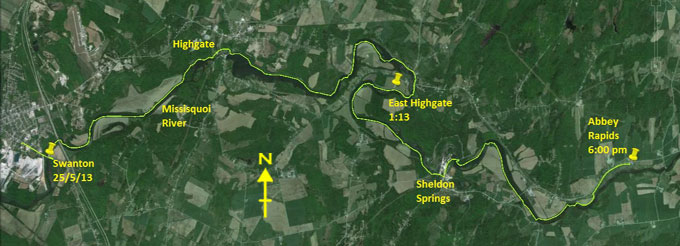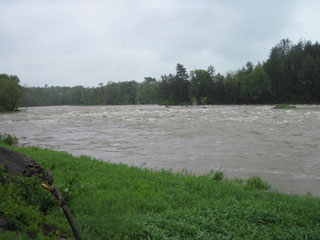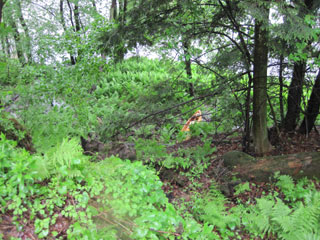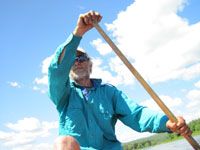
Day 7 route on Google Earth imagery
|
|
Last night was a bad night. I suspect it was the combination of many hours of hard exercise followed by a large intake of food.
Whatever, at about 2:00 am I was feeling extremely nauseous and sweating profusely, despite the cold room. And then my stomach rejected
the food. I spent nearly half an hour crouched over the toilet, but in the end felt better for it. A waste of food, though.
Maybe I should take it more easily today; I'm still feeling a bit fragile. Perhaps three days to Canoe and Co in Quebec rather than the
planned two will be a more realistic goal. I use the microwave to cook oatmeal and brew tea for breakfast. This starts to settle my
stomach.
The most urgent thing is to fix the seat if I can. I'm contemplating lashing a couple of steel rulers to the rails, and so head off to
find the hardware store in town. I take the seat with me, and at Aubuchon I'm shown some aluminium angle – just the job. I have it cut
to length, and also buy some nylon cord. Then it's back through the rain, still falling, to the motel room to lash the angle to the
broken rails. It's a tedious task but I'm pleased with the result. Whether it will hold or not, I have no idea, so resolve to carry the
ball with me. It's an insurance policy that weighs very few ounces, and the chances of finding another in time of need are slim in the
utmost.
|

Cracked seat rail ...
|

... and temporary repair
|
|
At about 9:00 am I check out and begin the trek back to the river, finding it running higher than yesterday, hardly surprising. It's
now hard to ferry glide across without losing ground. The rain had let up briefly during the night, but now comes down even harder.
This, together with a bitterly cold north wind, says that staying warm today is going to be a challenge. I'm wearing a thick thermal
shirt and an extra shirt under a cagoule, but can still feel heat being sapped.
An extra set of rapids prior to Highgate requires a carry as I'm unable to make progress. And then it's hard to reach the take-out at
Highgate Falls. On carrying to the dam the reason becomes evident: the falls are thunderous. I resume poking up the eddies, under the
silver maples which line the banks, sometimes behind them, anywhere that slack water, or slacker water, is available. It's a game of
patience. I have to remind myself that this is going to be a long day of patient paddling, and that I should not let frustrations mount
which might lead to a rash movement. A swim in these conditions would be catastrophic.
|

Highgate Falls from above
|

Finding slack water is not easy
|
|
There's no way to get anywhere near Sheldon Springs Dam – headway has become impossible – so I take out early on my right. There's a
steep bank to haul up, difficult as it's composed of wet mud which offers little resistance. At the top, though, there's a logging trail
parallel to the river, fairly recently cut and covered with small brush. I follow it, stumbling occasionally, and eventually find the
electricity sub-station on the alternative carry that I reconnoitred back in February.
|
|
This has added maybe a mile to the carry. Following the road, I reach the bridge and search for the put-in. All I can find is overgrown,
semi-flooded land on river right, no obvious access. After thrashing about in this for a while, I find a way to the water. It's
dangerously close to the dam, but the options are limited. I put in without incident and continue the slow passage upstream, soon
seeing the official portage signs well above the bridge.
|

A steep, muddy bank to haul the canoe up
|
|
Despite, or maybe because of, the conditions, I'm getting satisfaction from seeing how much progress I can make for as little effort as
possible. It distracts my mind from the fact that I'm otherwise cold and miserable. My waterproof trousers have decided that now is a
good time for the stitching to give way, seemingly all at the same time. They keep some wind off still, but my legs are soaked. I don't
fully trust my seat repair, so am not putting full weight on it, but prefer to kneel in these conditions anyway.
This slow progress continues for hours, dodging under trees, behind trees, ferry gliding across the river to find better eddies,
sometimes losing ground to do so, pushing off the bank, feeling the rainwater seep down my neck, feeling my body temperature drop and
drop.
Near the foot of Abbey Rapids progress grinds to a halt. I take out on my left and follow a farm trail around the edge of a field,
gradually homing in on Route 105 and the rail-trail which run parallel to the river. The rail-trail is the obvious carry route, and I
follow this. The rain continues heavily, and the north wind doesn't get any warmer. I recognise that I have signs of hypothermia. If I
can determine that, it's not too bad yet, but I need to do something about it, and soon.
A building with lights comes into view. It proves to be the Abbey Restaurant. I have no clue of what will happen next or where I will
spend the night, but I need to be indoors. I leave the canoe upside down behind the building and, dripping rucksack on my dripping back,
go inside. I'm hardly dressed for a visit to a restaurant, but the staff kindly turn a blind eye and are welcoming. The first
requirement is a drink of hot chocolate. I am shivering violently now, and have trouble coordinating hands and mouth, but gradually
manage to take it on board.
Another couple come in for dinner. I'm still standing by my table, letting the water drip off me rather than wetting the seat. They
take another table, but I'm obviously a talking point, so we strike up a conversation. I've been asking about possibilities for
accommodation and two suggestions have been made: The Dairy Center, only about 6 miles farther east (the “only” demonstrates perfectly
the prominence of the internal combustion engine in the American psyche), and a motel, about a mile back to the west. I'll happily walk a
mile in the wrong direction to get shelter for the night.
Then the couple, Scott and Diane, who are celebrating their 30th wedding anniversary, kindly invite me to share their table. I'm now very
interested in ordering food, although am wary of going overboard like last night. Soup seems like a safe way to start. In conversation,
they offer to ferry me back to the motel, an offer I'm all too happy to accept. A little later on, they make an even more generous offer
– to take me home with them for the night. The motel would have been fine, but this is even better. I have heard of the concept of Trail
Angels, mainly in the context of the Appalachian Trail, but now I have met some in real life.
We finish dinner, step out into the rain, strap the canoe to their car, and drive to their beautiful home a few miles away in Enosburg
Falls. Having forgotten to send a SPOT as I reached the restaurant, not knowing that it really was the end of the day, I send one now,
but feel compelled to phone Viveka to explain how I have come to be so far from the water. I must remember to leave a SPOT tomorrow
morning.
The dryer is pressed into action, and I enjoy another hot shower. My metabolism is doing strange things, especially my temperature
regulation, but the symptoms of hypothermia are subsiding fast. Once more I sink into a comfortable bed with immense gratitude to my
hosts, cradled in their generosity to a total stranger in need.
|
|







